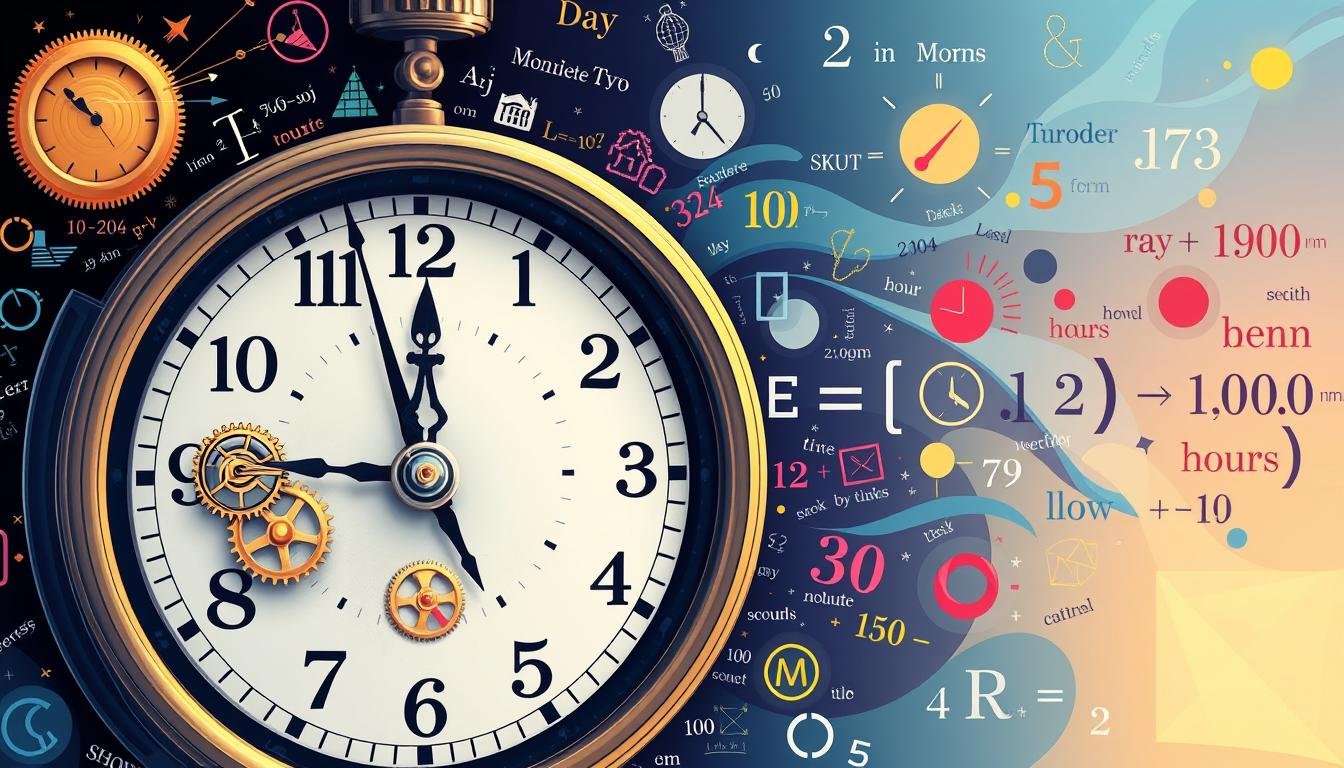A visually appealing and informative time conversion guide featuring various clocks and calendars arranged artistically, showcasing the relationship between months and seconds. Include a background of celestial elements like stars and planets to represent the passage of time, with clocks displaying different times and dates to emphasize the concept of time measurement. Use vibrant colours to create an engaging and educational visual experience.
Time conversion can be fun to learn. Let’s explore how many seconds are in a month.
The number of seconds changes with each month. This guide will help you understand time conversion better.
Time conversion is more than just math. It shows how we track our days and months.
Next, we’ll look at time units closely. You’ll soon know how many seconds are in a month.
Understanding Time Units
Time measurement helps us track our daily lives. Seconds are the basic unit of time. They build up to create minutes, hours, days, and months.
The smallest practical unit is the second. Sixty seconds make one minute, and sixty minutes form a single hour.
Twenty-four hours make up a complete day. Days add up to weeks, and weeks become months.
Months vary in length. Some have 30 days, others 31. February has 28 or 29 days, depending on leap years.
Our time system tracks microseconds to years. Each unit connects, creating a framework for understanding time.
Experts have devised ways to convert between time units, which helps in many areas, from projects to experiments.
How Seconds Are Calculated
The second definition has changed a lot over time. Modern time measurement uses exact atomic clocks.
These clocks track time using atomic vibrations. They measure time by watching caesium atoms move.
Scientists have made atomic clocks very reliable. Cesium-133 atom vibrations now define each second.
This exact measurement helps with time tracking around the world. It’s used in science and technology.
Atomic clocks are much better than old mechanical clocks. They stay accurate for millions of years.
Scientists are working on even better clocks. Optical atomic clocks might change how we measure seconds.
This shows how complex and interesting modern timekeeping is. It’s an area of ongoing scientific progress.
Common Month Lengths
Calendar months have different number of days. Some have 30, others 31. February is the shortest month, with 28 days.
Most months are 30 or 31 days long. Seven months have 31 days, and four months have 30 days.
Leap years change things up. Every four years, February gets an extra day, keeping our calendar in sync with Earth’s orbit.
These differences matter for precise time tracking. The number of days can affect second calculations.
People working in science or finance must watch these changes. Leap years add more complexity to time-related math.
Calculating Seconds in a Standard Month
A visually engaging illustration of a time conversion formula featuring a large clock face with detailed gears and mechanisms, surrounded by a colourful array of mathematical symbols and numbers. The background should depict an abstract representation of days and months flowing seamlessly, with a gradient from day to night to signify the passage of time. Elements like seconds turning into minutes and then hours should be subtly integrated into the design, creating a sense of dynamic movement and transformation.
A standard month has 30 days. This is the base for exact time measures.
To change a month to seconds, we use math. We break it down step by step.
First, find the hours in a month. Multiply 30 days by 24 hours.
This gives 720 hours. Now, turn hours into minutes.
Multiply 720 by 60. You get 43,200 minutes.
Last, change minutes to seconds. Multiply 43,200 by 60 seconds.
The entire math looks like 30 × 24 × 60 × 60 = 2,592,000 seconds.
This math gives the seconds in a 30-day month. Many experts use this to change time units.
Some months have 31 days. This changes the total seconds.
For exact math, check which month you’re using. The same time is key in science and tech.
Special Considerations
Calculating seconds in a month can be tricky. Several factors affect precise time measurements.
Leap seconds keep global timekeeping accurate. They stop our clocks from drifting away from astronomical time.
Daylight saving time adds complexity to time calculations. It causes shifts when clocks spring forward or fall back.
Time zones present another challenge. The world has many time zones with unique offsets from UTC.
Experts work to refine these calculations. Leap seconds are added to sync atomic clocks with Earth’s rotation.
These adjustments happen behind the scenes for most people. They ensure global time stays precise.
Understanding these factors shows how complex measuring seconds can be. It varies across different contexts and regions.
Fun Facts About Time
People have been curious about time for ages. Ancient cultures made unique ways to track it.
The Mayans made complex calendars. They mapped star events with incredible accuracy.
Different cultures used clever methods to mark time. Chinese water clocks from 725 BCE measured time with water flow.
Egyptian sundials split daylight into 12 parts. This early system still affects how we keep time today.
Native American tribes tracked seasons through nature. They watched animal moves and plant growth.
Australian natives used stars to understand time. They knew a lot about sky patterns.
The world’s best atomic clock is super precise. It would take 15 billion years to lose one second.
Time views differ across cultures. Western societies see time as a line.
Many Eastern cultures think of time as a circle. This shows significant differences in how people see time.
Practical Applications
Time management is vital in professional and scientific settings. Precise calculations help researchers and project managers streamline workflows and boost productivity.
Scientists often convert time units for data analysis. This helps track progress and plan international projects.
Project teams use these calculations to create timelines. They also estimate how many resources they’ll need.
Software developers use second-based calculations for various tasks. These include creating algorithms and managing cloud computing resources.
Detailed time tracking improves system performance. It also makes computational processes more efficient.
Time calculation skills can boost personal productivity. Breaking down time helps people understand their daily habits.
This knowledge allows for better work-life balance. It also helps create more structured schedules.
Time unit calculations are helpful in many fields. They help people make smarter choices about managing time.
Conclusion and Quick Reference
Understanding seconds in a month is more than math. It’s a valuable skill for many people in different jobs.
Our time conversion chart helps you convert months to seconds easily and shows how complex time measurements can be.
Knowing how to calculate time units helps with planning and helps you understand how time relates to things.
Quick guides make number changes more straightforward to understand. A typical month has 2,592,000 seconds.
But some months have different numbers of seconds. Knowing this helps you make better choices about time.
Time conversion isn’t just about numbers. It’s about understanding how time works.
Practice these calculations to learn more. Try different scenarios to see how time units connect.
FAQ
How Many Seconds Are in a Standard Month?
A standard 30-day month has 2,592,000 seconds, which is calculated by multiplying 30 days by 24 hours, 60 minutes, and 60 seconds.
Do All Months Have the Same Number of Seconds?
No, months vary in length. A 31-day month has 2,678,400 seconds.
February has 2,419,200 seconds in a non-leap year. In a leap year, it has 2,505,600 seconds.
How Can I Quickly Convert Months to Seconds?
Multiply the days in a month by 86,400. This gives you the total seconds in that month.
For example, a 30-day month is 30 × 86,400 = 2,592,000 seconds.
Why Do Seconds in a Month Matter?
Exact time measurements are vital in many fields. These include scientific research, project management, and computing.
How Do Leap Seconds Affect Time Calculations?
Leap seconds sync atomic time with Earth’s rotation. They can impact precise time calculations in science and technology.
Can I Use Online Calculators for Time Conversions?
Yes! Many online tools and apps can help. They quickly convert months to seconds, considering different month lengths and leap years.
Are There Cultural Differences in Time Measurement?
Some cultures measure time uniquely. However, most scientific and global applications use standard international time units.
How Precise Are Modern Time Measurements?
Modern atomic clocks are exact. They can measure time within a billionth of a second.
you may also read : What Date Is 3 Months From Today | Calendar Guide


